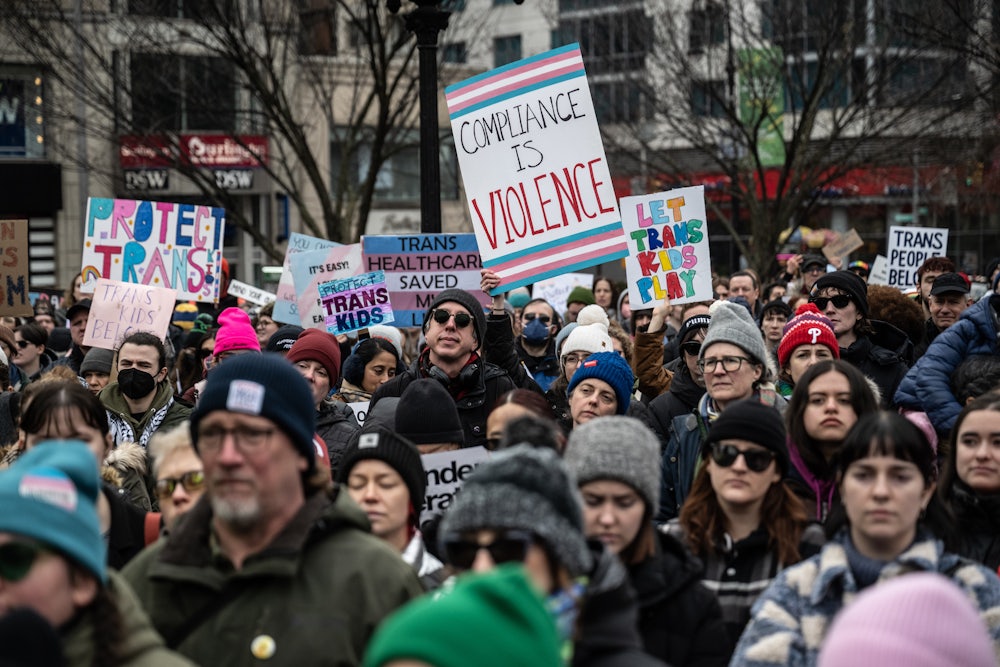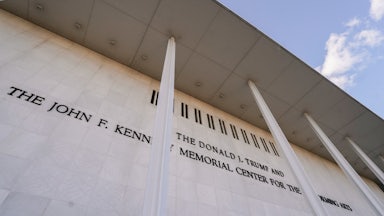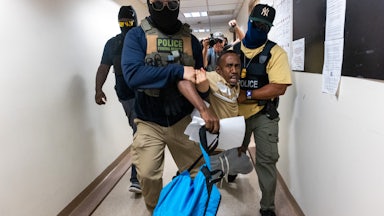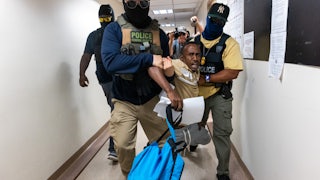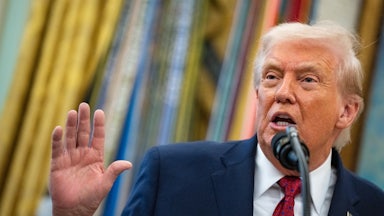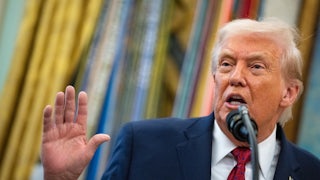“Do not obey in advance,” the opening advice historian Timothy Snyder offered dismayed citizens following Trump’s first election, has become almost a cliché in the wake of Trump’s return to power. Now, it’s being tested: Faced with a barrage of executive orders from Trump, universities and hospitals have had to decide how to respond. So far, the results may feel dispiriting, but that depends where you look.
On January 21, Trump issued an executive order directing all federal agencies “to combat illegal private-sector DEI” programs. It demanded that each federal agency identify “potential civil compliance investigations” in the private sector, including “large non-profit corporations or associations, foundations with assets of 500 million dollars or more, State and local bar and medical associations, and institutions of higher education with endowments over 1 billion dollars.” Before it was even clear how or if federal agencies would implement Trump’s directives, faculty and administrations began enforcing the orders on their own. “People like me are pre-emptively censoring themselves,” an anonymous tenured law professor in the University of California system told Inside Higher Ed earlier this month. “Seeing how ambiguous it is with respect to how they are defining diversity, equity and inclusion, and understanding that the ambiguity is purposeful,” the professor said, they removed “specialty in critical race theory” from their bio on the university website and to notify the university that they’d no longer be teaching a course in this subject, “so that I would not be a target either of the [Trump] administration or of the people that they are empowering to harass.”
Some university administrations appeared to come to the same decision, quietly censoring themselves—while also backpedaling once criticized in public. At Georgia Tech, after an email instructing a similar removal of “DEI” mentions from the school’s website leaked to the public, the university claimed they’d already begun “discontinuing” such programs in 2023. Michigan State University canceled a “low-key” lunch celebrating Lunar New Year, then apologized for canceling the event, with the college’s director of Diversity, Equity, and Inclusion office calling it an “over-reaction” to Trump’s order. There are likely more such instances, of internal-facing censorship, that have yet to come to light—and there will likely be more reversals once those decisions are inevitably made public.
“For decades universities were highly trusted institutions despite some conservative claims about them supposedly being hotbeds of radicalism,” said Victor Ray, associate professor of sociology at the University of Iowa (who spoke with TNR in an individual capacity) and author of the 2022 book On Critical Race Theory: Why It Matters & Why You Should Care. Long before Trump was amplifying panic about “Marxist maniacs” taking over elite institutions, conservatives spent years trying to gain credibility for their claims, getting inside universities by funding their own centers and scholars, and taking their fight to the media and general public with tales of purported left-wing excess on campus—”attempting to get a beachhead into higher education for their (bad, often wrong) ideas,” Ray explained, “coupled with a relentless public relations campaign claiming that liberal bias was ruining higher education.” These accusations cannot be separated from the reality that more people of color and women have entered academia, Ray added. “These rising numbers created a sense of threat, and in response conservatives tried to delegitimate higher education.”
At the same time, universities have made themselves vulnerable to these attacks. Through adjunctification, universities have reduced the number of tenure track jobs and their accompanying protections—and increased the number of adjuncts without such protections. “This means that higher education’s workforce is more precarious and less able to mount a collective response,” said Ray. Universities have also demonstrated their willingness to cave to pressure campaigns. “If Harvard was willing to throw their first Black woman President under the bus in a futile and self-defeating attempt to placate a racist movement, I don’t think many other universities will protect faculty when push comes to shove—although I would love to be wrong about this,” said Ray. “Similarly, the way universities have treated faculty and students protesting the war in Gaza sets a very dangerous precedent for suppressing speech and promoting state violence against demonstrators.”
Responding to student protests, universities changed their own disciplinary processes, and applied them more aggressively to Gaza protestors. They called in police to control and punish students for them, whether through mass arrests or through ignoring violence against students from counter-protestors. The last year has proven that many universities are willing to do the work of keeping their own campuses in line, even as Trump allies demanded university leaders be fired for supposedly not repressing protests enough.
Not long after Trump’s executive order attempting to ban gender-affirming care for anyone eighteen and under, some hospitals began complying by quietly canceling appointments. Hospital workers and community members quickly protested outside those same hospitals. Thousands gathered outside one NYU-Langone building, where some protestors and their family members had themselves received care. They were joined by health care workers, including those who work at those hospitals, speaking together as union members. “I’m standing alongside my colleagues,” said Dr. Michael Zingman, a child psychiatry fellow who spoke at the New York rally. “Let’s be clear: NYU’s decision is unnecessary and cowardly.”
Zingman was representing the Committee of Interns and Residents, a union of 37,000 interns, residents and fellows working in hospital systems across the country. CIR members have helped organize or spoke at rallies earlier this month in New York, California, and Washington.
After Children’s Hospital Los Angeles stopped providing gender-affirming care this month, CIR members in area hospitals began organizing quickly.
“I had strong relationships because of my union organizing,” said Dr. Frances Gill, a psychiatry resident in Los Angeles and a CIR/SEIU regional vice president for Southern California, which enabled workers in different hospitals and across departments in the same hospital to share information that the hospital was not. “So we had folks right away looking up, who are the hospital admin staff that made this decision, what’s their email address and how do we start an email campaign to flood their inboxes asking them to change their decision? And how do we get in touch with parents of patients that being affected by this?” Then CIR members co-organized a protest outside the hospital with Democratic Socialists of America (who also co-organized the New York protest), as well as a United Auto Workers local unit, Healthcare Workers for Palestine, and Queers for Palestine. About six hundred people turned out.
Though the hospital’s actions were driven by Trump’s order, the protest was not primarily about Trump. As much as it’s easy to get people fired up about Trump, Gill said, “people get even angrier at the people in liberal states or liberal cities where there’s this capitulation. The failure to fight back is even more activating, and in some ways more enraging.” This was also familiar terrain for the hospital workers who had been through union organizing, where they built relationships to one another and had the shared experience of pushing their employers, Gill added. “The inner workings and political dynamics of the employer, we can have a clearer sense of how to move folks.”
Ray told me that as far as organized resistance within universities, groups like the American Association of University Professors and PEN were already engaged in pushing back on Trump’s orders, with AAUP releasing a statement called “Against Anticipatory Obedience” in January and joining a legal challenge to one of the DEI orders. But as compared to the hospital setting, the power of professional organizations in academia is more limited. Challenges from faculty unions and faculty governance could go further. On Wednesday, the national coalition Higher Education Labor United organized a day of action in more than a dozen cities, under the banner of “Hands Off!” healthcare, research, and jobs, protesting cuts to the Department of Education, NIH, NSF, and more. Several hundred people turned out in Boston, Philadelphia, and Seattle, among others.
Still, individual faculty also need not wait for organized campaigns to push back. “One simple way is to simply keep teaching exactly as we have been,” said Ray. “This administration has made it clear that empirically verifiable knowledge itself is a threat to their plans, so they are attacking those of us who create knowledge.”
